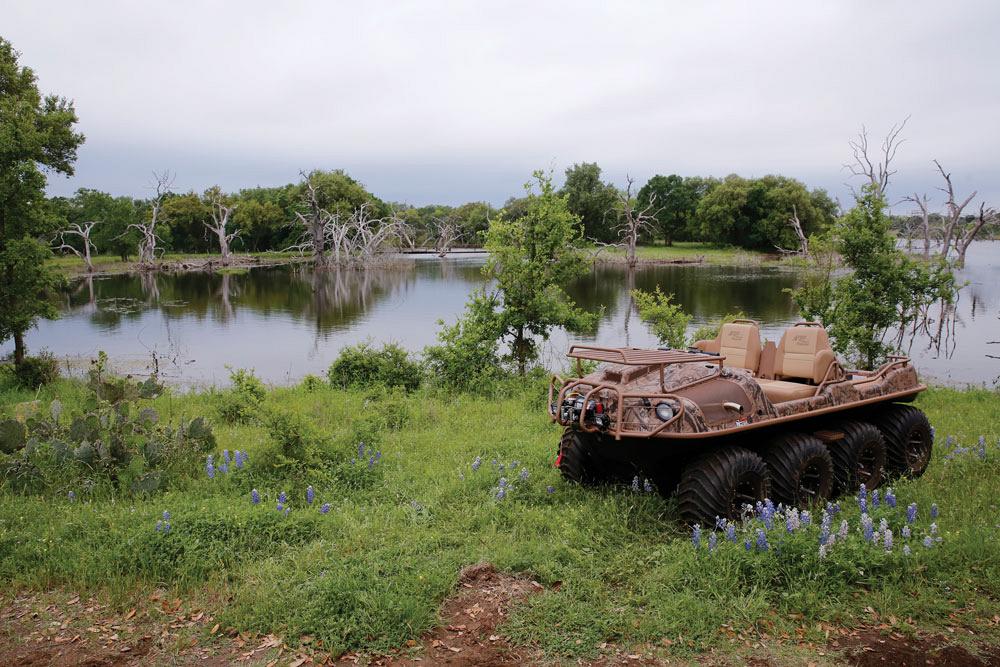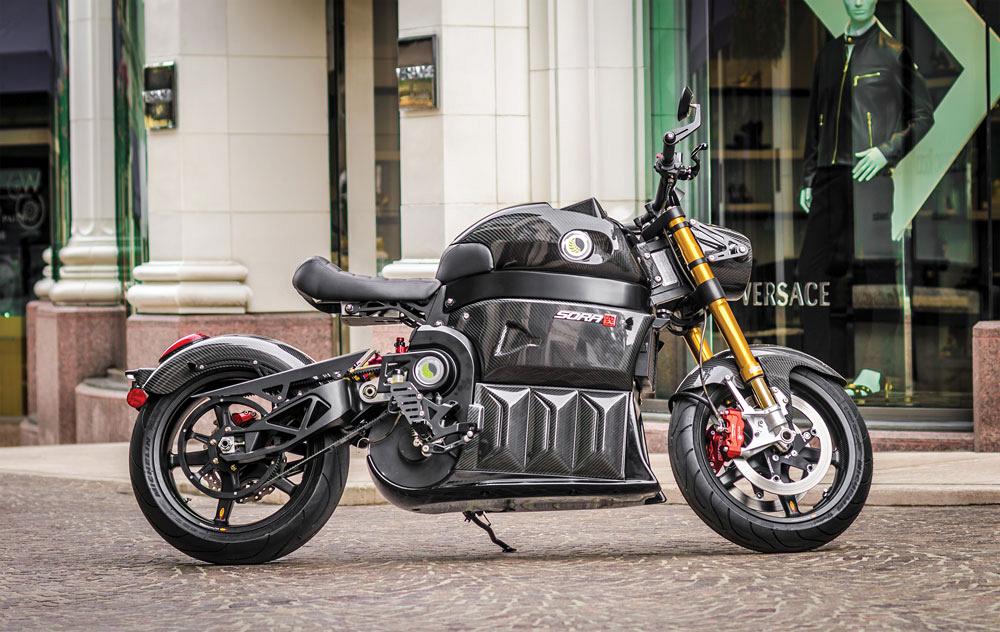- FMA
- The Fabricator
- FABTECH
- Canadian Metalworking
Transportation Outlook
Look Beyond the Usual Suspects for Work
- By Nate Hendley
- April 7, 2017
- Article
- Management

Ontario Drive & Gear builds the Argo amphibious ATV combining in-house manufacturing with locally outsourced machining, welded components, and laser cut parts. Photo courtesy of Ontario Drive & Gear.
Plenty of cars and SUVs are still being built in Canada, but the automotive sector faces some major challenges in the days ahead. OEMs are cutting back on production, and even the future of free trade is murky.
Shops in the automotive supply chain should consider alternative markets in the form of defence vehicles, all-terrain vehicles (ATVs), and motorcycles, to name a few.
The Numbers
But first the bad news: According to Scotiabank’s “Global Auto Report” released in February, some 2.37 million vehicles were manufactured in Canada last year. While this total is slightly higher than 2015 thanks to increases in truck production, automotive output is on the decline. The numbers don’t lie. In 2016 Canada made 802,100 cars versus 888,600 in 2015.
Research firm LMC Automotive, Troy, Mich., offers a dire forecast for the next few years. According to LMC, Fiat Chrysler Automobiles (FCA) will reduce the number of vehicles made in Canada from 577,000 in 2016 to 435,000 in 2020. Ford will drop to 184,000 from 272,000; GM will drop to 318,000 from 519,000; and Toyota will drop to 463,000 from 600,000. Production from Honda is expected to increase marginally to 425,000 in 2020 from 414,000 in 2016.
A lot of money is at stake. Canadian auto part shipments amounted to $25 billion in 2014, according to the Automotive Parts Manufacturers’ Association (APMA). Roughly 85,000 people worked directly in the auto parts sector that year, with many more working indirectly in the supply chain.
Fortunately, there are other vehicles beyond cars and SUVs to provide parts for.
Take the Argo, for example. The Argo is an amphibious ATV that can race around the outdoors, unencumbered by rocks, logs, mud, and water. The company that makes it, Ontario Drive & Gear (ODG), New Hamburg, Ont., describes the Argo as the top-selling amphibious Xtreme Terrain Vehicle (XTV) on the planet.
Currently 29 different Argo models are available, used by police and fire departments, emergency medical and search and rescue departments, farmers, forestry workers, utility and mining workers, the military, hunters, fishers, and outdoor enthusiasts.
ODG was established in 1962 in Kitchener, Ont., as a subsidiary of a German firm. The initial goal was to design and make power transmissions and gears. After a few years of tinkering, the company launched the Argo in 1967.
No longer a German subsidiary, ODG employs over 300 people and makes the Argo in its New Hamburg facility, where the company is currently headquartered.

The SORA motorcycle, manufactured in Quebec by Lito, is an example of a transportation manufacturing company that is excelling outside of the traditional automotive manufacturing marketplace. Photo courtesy of Lito.
“The Argo vehicle division facility has a press and weld department that is 15,000 sq. ft. In addition, [through other ODG-owned facilities] we have two other world-class facilities, including a gear division and a space, robotics, and defence division that specialize in axles, gear cutting, CNC machining, grinding, assembly, forging, and heat-treating material. In total we have 200,000 sq. ft. across all three plants,” said Dave May, vice president of operations at Argo.
The firm uses locally sourced suppliers for some machined components, weldments, and laser cutting.
“When we bring on a new supplier, we look for someone that can provide cutting-edge technologies and one that is ideally headquartered in North America, along one of our existing supplier transportation lanes. Having an ISO certification is an additional asset,” said May.
He said making parts for ATVs isn’t much of a stretch for anyone familiar with making parts for cars and SUVs.
“There really are very few differences in materials or processes for ATVs versus cars or SUVs. Each Argo part has an engineered drawing with tolerances and material and processing specifications that need to be met. The biggest difference between us and the automotive industry is that at such low production volumes, we’re not able to achieve the same economies of scale that a major automotive manufacturer can,” said May.
To May, the future looks bright, however.
“For 50 years Canada has been our strongest market. Looking into a crystal ball, there certainly is room for the market to expand and opportunities for machine shops to tap into that supply chain. We’re blessed in the sense that Canada is a country that has some of the world’s most vast and rugged terrain, making it an ideal market for ATVs, UTVs, and XTVs,” said May.
Other Vehicle Markets
Defence vehicles represent another solid sector to consider. One of the leading companies in this field is General Dynamics Land Systems-Canada (GDLS-Canada), London, Ont. GDLS-Canada won a $404 million contract from the Canadian government in February to upgrade 141 Light Armoured Vehicle (LAV) III vehicles.
“The recent contract amendment announced was a follow-on to existing work. We have a substantial Canadian supplier network in place for this contract,” said Doug Wilson-Hodge, manager of corporate affairs at GDLS-Canada.
GDLS-Canada is a division of General Dynamics Land Systems, itself part of the combat systems business group of the General Dynamics Corp. The company specializes in light armoured vehicle platforms and subsystem integration, as well as repairs, upgrades, and service. The firm has a very specific client base.
“We typically sell only to military and government customers,” said Wilson-Hodge. GDLS-Canada performs precision machining, product fabrication, assembly, prototype development, and systems integration.
“Our London plant spans a 300,000-sq.-ft. area and employs approximately 2,000 people. We have two machine shops with a total of five CNC machines, including a 5-axis vertical gantry mill,” said Wilson-Hodge.
The company also uses outside suppliers … a lot of them.
“GDLS-Canada supports more than 500 Canadian suppliers, across all regions in Canada. Suppliers must be able to help us meet our schedule, quality, cost, and technical-performance requirements,” said Wilson-Hodge.
Some of these requirements, technical or otherwise, are:
- Canadian Controlled Goods Program (CGP) certification
- ISO registration (quality program)
- 5-axis CNC machining capability
- In-house tooling development
- Full measurement capability
- In-house engineering capability
- Program management
- ERP/MRP system
- Machine maintenance program
- Recent capital investment (new equipment purchases)
“The defence market in Canada and elsewhere, specifically the armoured vehicle market, is a highly competitive and cyclical business. If potential suppliers believe they have a compelling product at an internationally competitive price, there are potential business opportunities,” said Wilson-Hodge.
Two Wheels, or Three?
Canada also is host to a homegrown specialty motorcycle manufacturing sector, typified by Bombardier Recreational Products (BRP) of Valcourt, Que. BRP’s products generate nearly $4 billion in annual sales. While primarily known for making snowmobiles, BRP also manufactures ATVs and a three-wheeled motorcycle under the Can-Am brand.
The Can-Am Spyder, introduced by BRP in February 2007, is classified as a three-wheeled motorcycle by the National Highway Traffic Safety Administration (NHTSA). The three-wheeler, which has a Y-frame design, two front wheels, and one back wheel, is made at BRP’s central production facilities in Valcourt.
Since 1998 BRP has also been producing ATVs. In February 2017, the company released its new four-person Can-Am Maverick X3 MAX side-by-side vehicle (an ATV with parallel seats). Lito, a new company in suburban Montreal, is another domestic motorcycle manufacturer with a pioneering product. The fledgling firm has created what it claims is the world’s first all-electric cruising motorcycle.
Founder and President Jean-Pierre Legris, who worked as an engineer for Hyundai in Japan and Peugeot-Citroën in France, started Lito in 2009 to fill a gap in the market. While major OEMs at the time were waking to the potential of electric cars, other sectors were largely untapped.
“I saw a big opportunity with motorcycles,” recalled Legris.
He decided to develop a 100 per cent electric motorcycle and formed Lito to achieve this goal. Lito designers and engineers spent years on R&D and then launched a prototype in 2012. The first commercial delivery of a SORA electric bike to a customer took place two years later. Since then Lito has sold a few thousand bikes, said Legris.
The SORA electric motorcycle is not cheap; models range from around U.S.$50,000 to $100,000. Legris is developing a more affordable model for police departments.“Right now we are delivering the motorcycle as a boutique [item]. Of course, we’re looking to have a more mainstream product. The first model was very focused on the high-net-worth individual. We will deliver a model to the police force [in March],” said Legris.
The bike’s current range is about 100 km on highways (double that in urban environments) and can hit speeds around 200 km/hour. The bike’s 12-kWh lithium-polymer batteries take eight hours to recharge in a regular outlet and three hours in a charging station. Unlike its gas-powered counterparts, the SORA motorcycle is quiet, doesn’t emit exhaust, and doesn’t have a clutch.
Lito also is working with another Quebec-based specialty vehicle manufacturer, Campagna Motors of Boucherville, to “electrify their ride,” as Legris puts it. The ride in question is the T-REX® three-wheeled, double-seated sports vehicle.
Lito is small, with eight workers in Montreal and two doing sales and marketing in Los Angeles. The company performs design and assembly at its headquarters and uses suppliers for machined parts and manufacturing. Legris wants machine shops with quick turnaround times, high-quality workmanship, and preferably experience with aluminum (the SORA chassis is largely aluminum and carbon fibre).
Legris is determined to bring electric motorcycles into the mainstream. If he succeeds, this could mean more opportunities for shops looking for alternatives to the traditional vehicle manufacturing supply chain.
“We want to focus on the police segment for the next few years or so, and that will open the door to the mass market for us. We are developing a new platform and a more affordable motorcycle for the masses,” said Legris.
Contributing writer Nate Hendley can be reached at nhendley@sympatico.ca.
About the Author
subscribe now


Keep up to date with the latest news, events, and technology for all things metal from our pair of monthly magazines written specifically for Canadian manufacturers!
Start Your Free Subscription- Trending Articles
Identifying the hallmarks of a modern CNC

Zoller to host 2024 Open House and Technology Days

Wheel line expanded to accommodate heavy-duty industries

Tooling for spot facing and counterboring is completely customizable

Collet chuck provides accuracy in small diameter cutting

- Industry Events
MME Winnipeg
- April 30, 2024
- Winnipeg, ON Canada
CTMA Economic Uncertainty: Helping You Navigate Windsor Seminar
- April 30, 2024
- Windsor, ON Canada
CTMA Economic Uncertainty: Helping You Navigate Kitchener Seminar
- May 2, 2024
- Kitchener, ON Canada
Automate 2024
- May 6 - 9, 2024
- Chicago, IL
ANCA Open House
- May 7 - 8, 2024
- Wixom, MI















